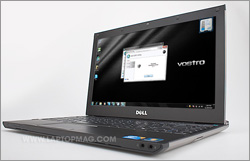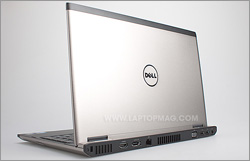Laptop Mag Verdict
Dell's follow-up to its slim business ultraportable packs a faster Core i5 processor but doesn't last long enough on a charge.
Pros
- +
Stylish brushed aluminum design
- +
Less than an inch thick
- +
Loud speakers
- +
HDMI port and added USB port
- +
Runs cool
Cons
- -
Battery life too short
- -
Expensive
- -
Long boot time
Why you can trust Laptop Mag
When Dell released the business-focused Vostro V13 notebook in March, we praised that machine's sleek and stylish aluminum chassis but lamented its lackluster speed and endurance. Now comes its successor, the Vostro V130, which keeps the stylish chassis but doubles the performance with a Core i5 processor, adds some ports, and includes new cooling technology. Unfortunately, the battery life is even worse this time around, making this ultraportable not very portable at all.
Editor's note: Portions of this review were taken from our earlier review of the Dell Vostro V13.
Design
Measuring a thin 13 x 9.1 x 0.7 inches and weighing a mere 3.6 pounds (just 0.2 pounds lighter than the V13), this ultraportable practically disappears into a messenger bag. Not that you'd want to hide it. For a small business notebook, the V130 is quite stylish. The lid and underside are made of brushed aluminum, and the inside is a matte black plastic; neither surface shows fingerprints, and the entire look is quite classy. Combined with reinforced zinc hinges, the V13 feels like it can survive the rigors of business travel. Similar to the Adamo and XPS 14 and 15, the V130's lid is hinged about half an inch forward of the back edge of the notebook.
Heat
For such a thin system, the V130 stayed fairly cool during our testing. The notebook is the first to employ what Dell calls Hyperbaric Cooling, which draws cool air into the notebook, rather than pushing hot air out. After playing a Hulu video at full-screen for 15 minutes, the touchpad registered 77 degrees Fahrenheit, the space between the G and H keys was 81 degrees, and the middle of the underside reached 91 degrees. Those temperatures are all cooler than the V13, which is impressive.
Keyboard and Touchpad
Sign up to receive The Snapshot, a free special dispatch from Laptop Mag, in your inbox.
The V130's keyboard is a mixed bag. The keys abut each other at the base, and the top of each is terraced, much like the HP EliteBook 2540p. The layout is certainly large enough, but the keys made a fair amount of noise while typing. The keyboard also isn't as comfortable to use as the one found on the Lenovo ThinkPad Edge 13.
Considering it's such a small notebook, we were pleased with the size of the 3.2 x 1.7-inch touchpad. While the same color and material as the keyboard deck, it's slightly recessed, making it easy to find by feel alone. The touchpad itself offered little to no friction, and the discrete mouse buttons offered just the right amount of resistance.
Display and Audio
Click to enlargeThe antiglare display on the Vostro V130 had very good viewing angles from the sides to nearly 180 degrees, and it was also easy to see when tilted back as far as it would go; however, the screen became washed out as we tilted it forward. While watching videos streamed from Hulu, colors were very good, and contrast was acceptable. Its resolution of 1366 x 768 is standard for a 13.3-inch screen, and we were able to comfortably view two open windows side by side.
Despite the fact that this notebook is not geared towards the entertainment crowd, the V130's single speaker was quite loud, offering excellent fidelity.
Ports and Webcam
Where the V13 only had one USB port, Dell thankfully added another to the V130. It also added an HDMI port, which complements eSATA/USB, Ethernet, and VGA. As with the V13, all the ports are on the back, save the 5-in-1 memory card reader on the right (the ExpressCard/34 slot is gone) and the mic and headphone jacks on the right front lip.
The 1.3-megapixel webcam offered fairly good images during a Skype video call; it was able to accurately capture skin tones. We like Dell's Webcam Central software, which allowed us to tweak the image quality, and add fun avatars and effects. Also, the face tracking feature was quick and responsive when we moved our head around.
Security and Backup
Customers have a few backup and security options to choose from: Dell DataSafe Online Backup stores the contents of your system in the cloud; you can store up to 2GB for free for a year; after that, you can select storage options of 10GB ($29.99), 30GB ($39.99), 50GB ($49.99) and 100GB ($59.99). Standard on all systems is a freefall sensor on the motherboard that parks the hard drive in case the V130 is dropped. Unlike the V13, customers can no longer opt for a 7,200-rpm, 250GB hard drive with Full Disk Encryption.
Support options include Dell ProSupport, which provides round-the clock IT help not only for hardware, but also for tutorials of applications such as Norton AntiVirus, Microsoft Office, Microsoft Small Business Server, Intuit QuickBooks, Adobe Photoshop, and Adobe Acrobat.
Performance
A 1.33-GHz Intel Core i5-470U processor and 4GB of RAM powered the V130 to a PCMark Vantage score of 4246, nearly 1,400 points higher than the V13 and almost 700 points higher than the ultraportable average. Still, this showing is more than 2,000 points below the Toshiba Portege R700, which has a 2.4-GHz Core i5 CPU.
The 7,200-rpm, 500GB hard drive duplicated a 4.97GB folder of multimedia files in 2 minutes and 33 seconds, a rate of 33.3 MBps. That's 3 MBps faster than average, and 0.5 MBps faster than the Portege R700. Unfortunately, the V130 boot into Windows 7 Professional in an abysmal 1 minute and 46 seconds.
The V130's integrated Intel HD graphics are twice as powerful as the V13's 4500MHD GPU, but that's not saying much. The V130 scored 1,147 on 3DMark06, which blows away the V13 (554), but is still about 200 points shy of the ultraportable average. When playing World of Warcraft, the system managed an unplayable 13 frames per second with the resolution set to 1366 x 768, and graphics at optimal, well below the category average of 44 fps.
Battery Life and Wi-Fi
Sadly, the V130's endurance was just 2 hours and 45 minutes, even less than the already-disappointing V13's battery life of 4:19. That's nearly two hours short of the ultraportable average. This potential dealbreaker is made worse by the fact that the battery is integrated into the notebook, and can't be swapped out for a new one.
The V130 uses an Intel WiFi Link 5100AGN wireless card. At 15 feet from our access point, we saw throughput of 25.6 Mbps, and at 50 feet, throughput was 15.7 Mbps. Both are below the respective averages of 29.7 and 19.8 Mbps.
Select configurations of the V130 (starting at $753) will be available with integrated wireless broadband (DW5540 for AT&T; DW5620 (Gobi2) for Verizon and Sprint). A $792 configuration (Core i3-380UM, 4GB of RAM, and a 500GB hard drive) will also have WiMax.
Greenness
Click to enlargeWhile the V130 has a paltry EPEAT Bronze rating of 7 (21 out of 27 is more typical these days), the notebook was very efficient when it came to recharging its battery. Taking just 1 hour and 38 minutes, the notebook drew an average of 20.2 watts during that time, for a LAPTOP Battery Efficiency Rating of 12--well below the ultraportable average of 20.2.
Configurations
The V130 will be offered in 21 different hardware configurations, including Celeron U3400, Core i3, Core i5, Mobile Broadband, and Wi-Max enabled options. Pricing starts from $429 for the entry configuration, while the top-end Core i5, 4GB DDR3, 128GB Solid State hard drive configuration starts at $1,073.
Software and Warranty
The V130 comes fairly free of trialware. Bundled options include only Microsoft Office Starter, and a 15-month subscription to Trend Micro Worry Free for Business. Dell backs this notebook with a one-year basic limited warranty, plus one year of mail-in service. Configurations (such as ours) also come with one-year next business day on-site service (instead of mail-in). Users can extend their basic Limited Hardware Warranty from one to three years to stay covered into the future. To see how Dell fared in our Tech Support Showdown, click here.
Verdict
With any ultraportable, there's a delicate balance between power and portability. A notebook needs to perform certain tasks well, but if it uses up its battery too quickly, its usefulness for business travelers is mitigated. While we like that the $928 Dell Vostro V130 has a very slim profile and decent muscle, its sub-3-hour endurance is too short to ignore. For nearly the same price, you can get a Toshiba Portege R705 with a Core i5-460M processor and a 500GB hard drive, which should last nearly 6 hours on a charge. If you're willing to live with a smaller display, you can also pick up the Core i7-powered Acer TimelineX 1830t ($899) or the 11-inch MacBook Air ($999), both of which last much longer on a charge.
Dell Vostro V130 Specs
| Bluetooth | Bluetooth 3.0 + EDR |
| Brand | Dell |
| CPU | 1.33-GHz Intel Core i5-470UM |
| Card Slots | 5-1 card reader |
| Company Website | www.dell.com |
| Display Size | 13.3 |
| Graphics Card | Intel HD |
| Hard Drive Size | 500GB |
| Hard Drive Speed | 7,200rpm |
| Hard Drive Type | SATA Hard Drive |
| Native Resolution | 1366x768 |
| Operating System | MS Windows 7 Professional (32-bit) |
| Ports (excluding USB) | Microphone, Headphone, HDMI, Ethernet, eSATA/USB, VGA |
| RAM | 4GB |
| RAM Upgradable to | 4GB |
| Size | 13 x 9.1 x 0.7 inches |
| Touchpad Size | 3.2 x 1.7 inches |
| USB Ports | 2 |
| Video Memory | 256MB |
| Weight | 3.6 pounds |
| Wi-Fi | 802.11b/g/n |
Michael was the Reviews Editor at Laptop Mag. During his tenure at Laptop Mag, Michael reviewed some of the best laptops at the time, including notebooks from brands like Acer, Apple, Dell, Lenovo, and Asus. He wrote in-depth, hands-on guides about laptops that defined the world of tech, but he also stepped outside of the laptop world to talk about phones and wearables. He is now the U.S. Editor-in-Chief at our sister site Tom's Guide, where he oversees all evergreen content and the Homes, Smart Home, and Fitness/Wearables categories for the site..


